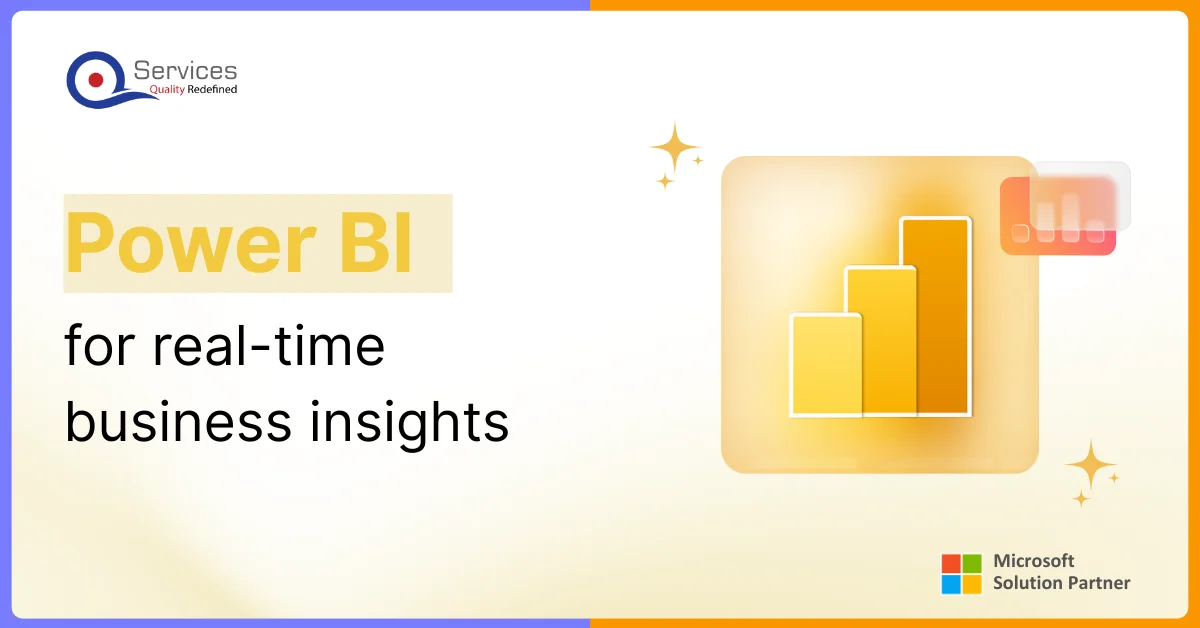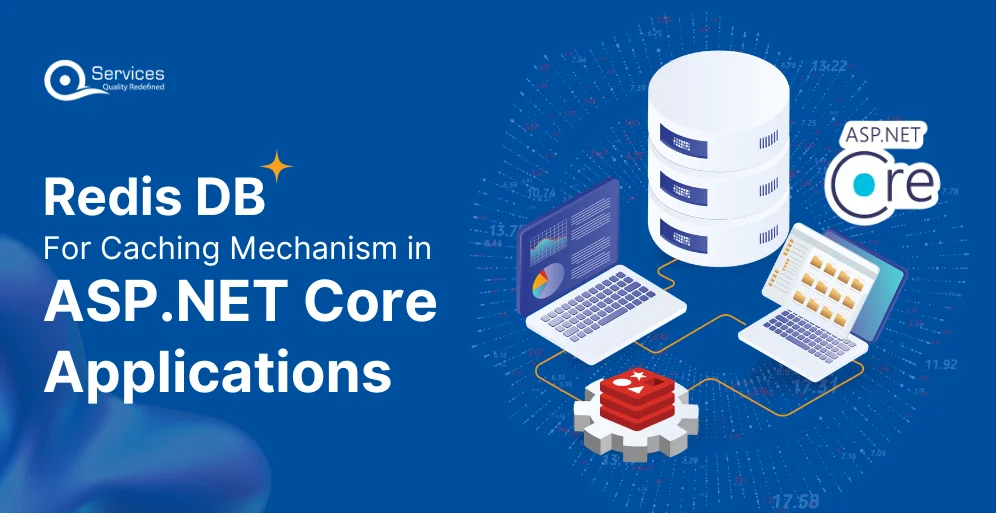
Home » Using Redis DB for Caching in ASP.NET Core Applications: Best Practices

It’s no longer news that performance is a key part of modern web application development. When talking about ASP.NET Core applications, there are several ways to improve their performance, one of them being the implementation of a cache. In this regard, Redis nodejs , an in-memory database, is one of the most used solutions for caching. In this blog, we will explain how to use Redis for caching in ASP.NET Core web applications and discuss some rules of thumb that will help you speed up your website.
In simple words, Redis caching means storing pieces of data in memory which can now be retrieved later as needed. This means that whenever the same piece of data needs to be fetched multiple times or is costly to calculate then that data will be stored, instead of pushing all requests to the databases and third–party APIs which reduces the response time by a big margin.
Enhanced Speed: Caching the most frequently accessed data avoids the need for continuous database or API requests, resulting in faster response times.
Ability to Expand: Redis, due to its implementation as a cache residing on RAM, allows the use of cluster mode for caching on different servers or instances. This ensures that your application is scalable.
Dynamic Data Types: Redis allows you to work with more than just strings when caching data, such as: B. Using lists, sets, or hashes.
Data Security Options: Despite the fact that Redis is usually employed as a RAM cache, it also has some data backup options like snapshots and append-only files.
The main reason why most people prefer to use node.js redis to add caching to their applications are because Redis is fast, can store many types of data (strings, hashes, lists, etc.), and can be used seamlessly with .NET Core applications. Additionally, Redis can be used as a distributed cache, which makes it useful in highly available and elastic cloud environments.
Get free Consultation and let us know your project idea to turn into an amazing digital product.
Let’s take a moment to get a better understanding of how Redis works before exploring its use as a cache in ASP.NET Core. So, node redis works on the concept of ‘Key-Value’ pairs, Where a key represents the unique identification of the data stored in cache and the value is the actual data that is mapped to that key.
The term Redis caching refers to the use of Redis as an in-memory data store to cache frequently accessed data temporarily. It aims to decrease latency by reducing repeated queries to the database system, and, therefore, enhance the functioning of the application. Most popularly, this is pursued by virtue of fast data retrieval and low latency as well as its support for a multitude of data types, including strings, hashes, lists, and sets.
To cache Redis, you configure it to store data in memory rather than making repeated database calls. Normally, Redis is set up as a cache layer between the application and the database management system, with which frequently queried data is stored in Redis, from where it can be retrieved much faster than from a traditional database.
Redis means a cache that uses Redis’s fast data structures in memory to temporarily store data. This includes:
Using Redis with Node.js, Redis allows you to cache data for various expiration times, reducing the frequency with which some data needs to be accessed from slower storage systems such as SQL databases or external APIs.
To query Redis cache, you utilize Redis commands like GET, SET, HGETALL, HSET, and so on, to retrieve and store information in the cache. For example, in a Redis node js example, in a .NET Core application, we would leverage the StackExchange.Redis library to interact with Redis.
IDatabase db = redis.GetDatabase();
var cachedData = db.StringGet(“key”);
This query retrieves the value of the key from the Redis cache. If the key is not found, it returns null or a default value.
When you hear about caching in Redis, it usually refers to the caching strategy that Redis uses in its system. Redis acts as a cache for data that is retrieved from slow or persistent storage (such as a database).
To implement caching with Redis:
Redis as a cache refers to using Redis solely for temporary data storage that expires after a defined time period. It’s a high-performance alternative to database queries, ensuring your application runs faster by reducing latency. You can use Redis to cache things like user sessions, frequently queried data, API responses, etc.
A Redis node tutorial typically covers the following steps:
Example Code:
var redis = ConnectionMultiplexer.Connect(“localhost”);
IDatabase db = redis.GetDatabase();
db.StringSet(“myKey”, “myValue”);
A Redis cache stores frequently accessed data in memory, allowing future requests to be served more quickly. In web applications, a Redis cache offloads requests for frequently used data, such as user sessions, search results, and so on, significantly reducing the load on your database.
Advantages:
Redis as cache is another way of saying you’re using Redis for the sole purpose of storing transient data. This data is usually non-critical and may be refreshed or discarded after a certain period. This is ideal for data that doesn’t need to be persisted permanently but should be readily available to improve application speed.
Redis cache database refers to the set of in-memory databases that Redis can use. By default, Redis has 16 logical databases (indexed 0 to 15). You can choose which database you want to use or configure multiple Redis instances for different purposes.
For example, in a Redis configuration, you can set:
databases 16
This setting tells Redis to use 16 logical databases.
To use Redis cache in your application, follow these steps:
Example in .NET Core:
IDatabase db = redis.GetDatabase();
db.StringSet(“userSession”, sessionData, TimeSpan.FromMinutes(30));
Redis cache database stores cached data in a specific database in the Redis server. Redis provides multiple databases so that you can logically split your cached data. By default, Redis provides 16 databases, but you can configure the number as needed.
You can switch between databases in Redis using the SELECT command, which lets you target a particular database for queries:
SELECT 0
To use Redis as cache, you would:
.NET Core Redis refers to integrating a Redis cache into a .NET Core application, typically by interfacing with Redis using the StackExchange.Redis library, which enables efficient caching and session management, improving the overall performance of your app.
Steps to integrate:
Redis .NET Core is simply the practice of utilizing Redis as a caching solution within a .NET Core application. It involves the same process as any other Redis integration but using .NET Core-specific methods and libraries.
.NET Redis generally refers to the use of Redis in .NET applications (not necessarily limited to .NET Core). Redis can be used for caching, session management, and data storage in both .NET Framework and .NET Core applications. The StackExchange.Redis library is the recommended .NET client for interacting with Redis.
Redis .NET refers to using Redis caching within any .NET-based application, including older .NET Framework applications. Redis helps in reducing the load on backend databases and speeds up response times for .NET applications.
Caching in .NET Core can use an in-memory cache, a distributed cache (using Redis or SQL Server), or other external caching systems to temporarily store data. Redis is a popular choice for distributed caching in .NET Core due to its speed and reliability.
To implement caching:
Example:
services.AddStackExchangeRedisCache(options =>
{
options.Configuration = “localhost”;
});
A Redis cache API allows you to interact with Redis programmatically. It provides methods to set, get, remove, and expire cache data. When building a caching layer, using a Redis API helps abstract the caching logic so your application can access cached data seamlessly.
ASP.NET caching refers to a caching mechanism in ASP.NET applications that stores data to avoid redundant calculations and database calls. Using Redis as an external cache provider for ASP.NET improves scalability and performance.
ASP.NET Core comes with built-in support for distributed caching with Redis:
public void ConfigureServices(IServiceCollection services)
{
services.AddDistributedRedisCache(options =>
{
options.Configuration = “localhost”;
options.InstanceName = “SampleInstance”;
});
}
.NET Core cache is a system for storing data temporarily in a fast-access storage layer to improve application performance. Redis is widely used for .NET Core caching due to its speed and reliability in handling high volumes of requests.
ASP.NET Core Caching refers to the caching system available in ASP.NET Core. It supports both in-memory and distributed caches (such as Redis). Caching helps reduce database load and improve application response times.
.NET Core caching involves using the built-in caching libraries (like IMemoryCache, IDistributedCache) in conjunction with external caching systems like Redis. It significantly reduces latency by storing data in fast, temporary storage and provides scalability for large applications.
ASP.NET Core caching integrates caching solutions like Redis for better performance, session management, and scalability. Redis can be configured for distributed caching in an ASP.NET Core application to ensure fast, global access to cached data.
Now let’s see how to use Redis step by step for caching in ASP.NET Core applications and some best practices for implementing Redis caching effectively.
Setting Up Redis in Your ASP.NET Core Application Before you start implementing Redis caching in your application, you need to set up Redis. Here’s a basic guide to get started:
Download and install Docker Desktop for Windows from the Docker website.
This will start a Redis server in a Docker container.
In your ASP.NET Core project, you need to install the StackExchangeRedis NuGet package, which is the official Redis client for .NET:
Open the Startup.cs file (or Program.cs for .NET 6 and later) and configure Redis by adding it to the services container:
Now you have Redis set up on Windows, and it’s ready to be used in your ASP.NET Core applications!
Once Redis is configured, you can start caching data. Let’s look at how to implement caching with Redis in an ASP.NET Core app.
Here’s an example of caching data (like a user profile) for 10 minutes:
In this example:
Example Response Time Without Redis:
Example Response Time using Redis cache:
Another useful scenario is caching API responses. Using Redis to cache API responses can significantly reduce the load on your backend and improve user experience. For example:
Cache Key Generation:
The cache key is constructed using the city name and is made case-insensitive by calling ToLower() on the city. This ensures that cache retrieval works regardless of how the city is typed by users.
Redis Cache Lookup:
The GetStringAsync method checks whether cached data for the specified city already exists.
If the cache contains the data (cachedData is not null or empty), the controller returns the cached response.
If no data is found in the cache, it simulates an external API call to retrieve weather information for the specified city. This is done in the GetWeatherForecastFromAPI method (which you should replace with a real external API call like OpenWeatherMap, WeatherStack, etc.).
The weather data retrieved from the external API is serialized into a JSON string and stored in Redis with a cache key (cacheKey).
The cache expiration is set to 1 hour (TimeSpan.FromHours(1)), which means the data will be updated after 1 hour.
Finally, the weather data (either from cache or external API) is returned to the client in a JSON format.
How to Use This Code:
When a user requests the weather forecast for a specific city, the API checks if the data is available in the Redis cache.
If the data is cached, it returns the cached data instantly.
If the data is not in the cache (for the first time or expired cache), it calls the external weather API, stores the response in Redis, and returns the data to the user.
The cached data will be automatically refreshed after the expiration period (1 hour in this case).
First request (cache miss): Call the external weather API, store the response in Redis and return it to the user.
Subsequent requests (cache hit): Return the cached data immediately from Redis without calling the external weather API, thus improving response time.

Reduced Load on External API: By caching weather data, you minimize repeated calls to the weather API, which can reduce costs and API rate limits.
Improved Performance: Responses are served faster from Redis cache, improving the overall user experience, especially for frequently requested cities.
Flexible Cache Expiration: You can control how long data is cached based on your needs (e.g., 1 hour, 24 hours, etc.).
Example response time without using Redis:
Example Response Using Redis :
Cache expiration is crucial in ensuring that stale data does not remain in the cache. Redis supports different strategies for cache expiration:
You can remove data from the cache either manually or automatically. For example, if a user profile in the database is updated, you may need to delete the cached version of that user profile. This can be done using the Remove method.
await _cache.RemoveAsync(cacheKey);
If your application is distributed (e.g., multiple Node.js Redis instances or services running on separate servers), Redis for caching ensures that all instances share the same cache. This guarantees consistency across all parts of your system.
Redis offers a variety of data structures (sets, lists, hashes, etc.) that you can use to cache more complex objects or to manage sets of data that you need to query efficiently.
Entity Framework Core allows you to further optimize data retrieval by caching the results of queries, by caching the results of common queries or frequently accessed data.
var cachedData = await _cache.GetStringAsync(cacheKey);
if (string.IsNullOrEmpty(cachedData))
{
var data = await _dbContext.Users.ToListAsync();
var serializedData = JsonConvert.SerializeObject(data);
await _cache.SetStringAsync(cacheKey, serializedData);
}
Using Redis caching with ASP.NET Core applications can not only enhance application performance but also reduce the load on the database. This results in better user experience. Following best practices, proper cache expiration strategies, using Redis for distributed caching, and integrating Redis with Entity Framework Core will make your web applications faster and more efficient.

Pipeline failures can be expensive and harmful to the environment. Companies are using IoT applications in the oil and gas industry to prevent these breakdowns and stay ahead of problems.
![Azure IoT vs AWS IoT vs Google IoT Pricing: Feature Comparison Chart for Enterprise [2025]](https://www.qservicesit.com/wp-content/uploads/2025/03/Microsoft-Teams-vs-Slack-vs-Zoom-TCO-Analysis-for-Enterprise-Organizations-2.webp)
The Internet of Things (IoT) helps businesses run better by connecting devices, collecting information, and improving choices. But picking the best IoT cloud provider can be confusing. The main three are AWS IoT vs Azure IoT vs Google IoT.

In this blog, we’ll explore how these advances are shaping the future of field services and how companies are adapting to stay ahead in a competitive market. What are the key changes that businesses need to embrace to stay relevant and efficient?
AWS CloudFront offers more edge locations globally, providing broader coverage and potentially lower latency. It has over 225 PoPs (Points of Presence) worldwide. Azure CDN, though global, has fewer PoPs, which might result in slightly higher latency in certain regions. AWS CloudFront’s extensive global infrastructure is an advantage for worldwide scalability.
AWS CloudFront integrates seamlessly with other AWS services like S3, EC2, Elastic Load Balancer, and more. It allows users to manage content delivery while taking full advantage of the AWS ecosystem. Azure CDN also integrates well with Azure services, such as Blob Storage, Azure Web Apps, and Azure Media Services, making it the ideal solution for businesses already using Microsoft Azure.
AWS CloudFront generally tends to be more expensive than Azure CDN, particularly for large-scale usage. Both services offer pay-as-you-go pricing, with costs based on data transfer, requests, and geographic regions. AWS CloudFront also offers a 12-month free trial with some limitations. Azure CDN has more flexible pricing models and can be more cost-effective depending on usage.
Both CDNs provide SSL/TLS encryption for secure content delivery. AWS CloudFront includes robust security features like AWS Shield for DDoS protection, AWS WAF for web application firewall protection, and AWS Certificate Manager for free SSL certificates. Azure CDN provides DDoS protection through Azure DDoS Protection, integrates with Azure WAF for security, but lacks the same advanced security services available with AWS.
Both CDNs are built to handle traffic spikes efficiently. AWS CloudFront’s global network of edge locations can distribute high traffic loads seamlessly across regions, ensuring low latency and high availability. Azure CDN is also designed for scalability, but its performance during extreme traffic spikes may depend on regional infrastructure and configuration.
For e-commerce websites, AWS CloudFront is often the better choice due to its low latency, dynamic content acceleration, and robust security features like SSL/TLS encryption and AWS Shield. CloudFront’s ability to scale globally with minimal downtime makes it an excellent solution for online stores, especially for high-traffic periods such as sales events.
AWS CloudFront provides real-time metrics and logs to monitor traffic, cache hits/misses, and other performance data. This is integrated with Amazon CloudWatch for more advanced monitoring. Azure CDN offers detailed logging through Azure Monitor, which enables users to track content delivery and identify performance bottlenecks.
Both AWS CloudFront and Azure CDN support SSL/TLS for secure content delivery. AWS CloudFront offers free SSL certificates through AWS Certificate Manager, while Azure CDN also supports SSL certificates but may require users to purchase certificates from third-party providers unless using Azure’s own services.
AWS CloudFront offers advanced DDoS protection through AWS Shield, which provides two levels of protection: Standard and Advanced. Azure CDN integrates with Azure DDoS Protection, which provides essential DDoS defense, though AWS Shield is generally considered more comprehensive in its protection.

Founder and CEO

Chief Sales Officer
